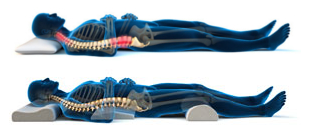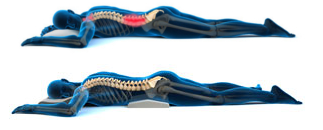For most people suffering with back and neck pain, sleep may not be as pleasant. To better deal with such dilemmas, it is helpful to understand and know what you can do to alleviate your condition and prevent further damage. With proper guidance and a proactive attitude, you don’t need to simply manage the condition, but improve it.
Back Pain Sleeping Positions
Back pain can be triggered by a number of reasons such as osteoarthritis, cervicalgia, degenerative disc disease, spinal stenosis and sciatica, to name some. The best determine which sleeping position will work best for you, you need to know what is the underlying cause of your back pain.
Supine Position
There are no rules when it comes to sleeping, but there are certain guidelines that you can follow to ensure a more comfortable sleep. If you prefer to sleep on your back, it is advisable to place a pillow underneath your knees, and another one under the small of your back. In this position, gravity can force the back to arch abnormally.
If you have sciatica or low back pain, sleeping in this position can be a challenge. So be sure to provide support on your back and beneath the back of your knees to alleviate any pressure on the lower back. A good variation of this position is to lie on your back but with both knees slightly bent.

Side Lying
Now, if you prefer to sleep on your side, then that’s a good thing. Most experts consider this as the best position for people with back pain. However, keep in mind that you will still need pillows for support, one placed between your knees and under the waist. This position is best adapted by people who are in the inflammatory stage of pain, where even the most minimal movement can trigger pain.

Prone Lying
This refers to lying on your stomach. In this particular position, gravity forces your back to arch towards the stomach. This can be uncomfortable for people with low back pain. To best accommodate this position, place a pillow under the stomach. This will effectively prevent your back from arching too much.

Neck Pain Sleeping Positions
Fact: for every single inch that the head is move to a forward position, its weight increases by up to 10 pounds. Abnormal neck posture can lead to a number of complications such as disc herniations, muscle strain, arthritis, and pinched nerves. Sleeping positions can affect as well as trigger neck pains. Abnormal alignment of the neck to the spine can result to joints deteriorating faster, and cause strain to the bones, muscles and ligaments.
The best approach to remedy neck pain is to correct posture, whether during sleep or when in an upright position. Since sleep should allow the neck and back to relax and relieve it from tension, it is beneficial to study the different positions and how to ensure proper alignment of the neck and spine.
Supine Position
For people suffering from neck pains, this is the most idea position since it works well with the normal curvature of the spine. In this position, the head and neck should be supported by a pillow, as well as under the lower back area.
Side Sleeping Position
This is another acceptable position but will require additional support. Pillow should be placed between the knees. With this support, there will be no need to provide lumbar pillows. However, raising of one arm above or under the head is not advisable, as it puts undue tension on the neck and shoulders. This position may also compress the
Prone Position
There are people who are used to sleeping on their stomach. If you have neck pain, it is best to avoid this position as it increases the risk of aggravating the pain on the neck and lower neck. However, people who sleep in this position usually find it difficult to adjust their sleeping positions. You can work around this but putting a good assistance pillow under the head and neck as well as another pillow beneath the abdomen.

